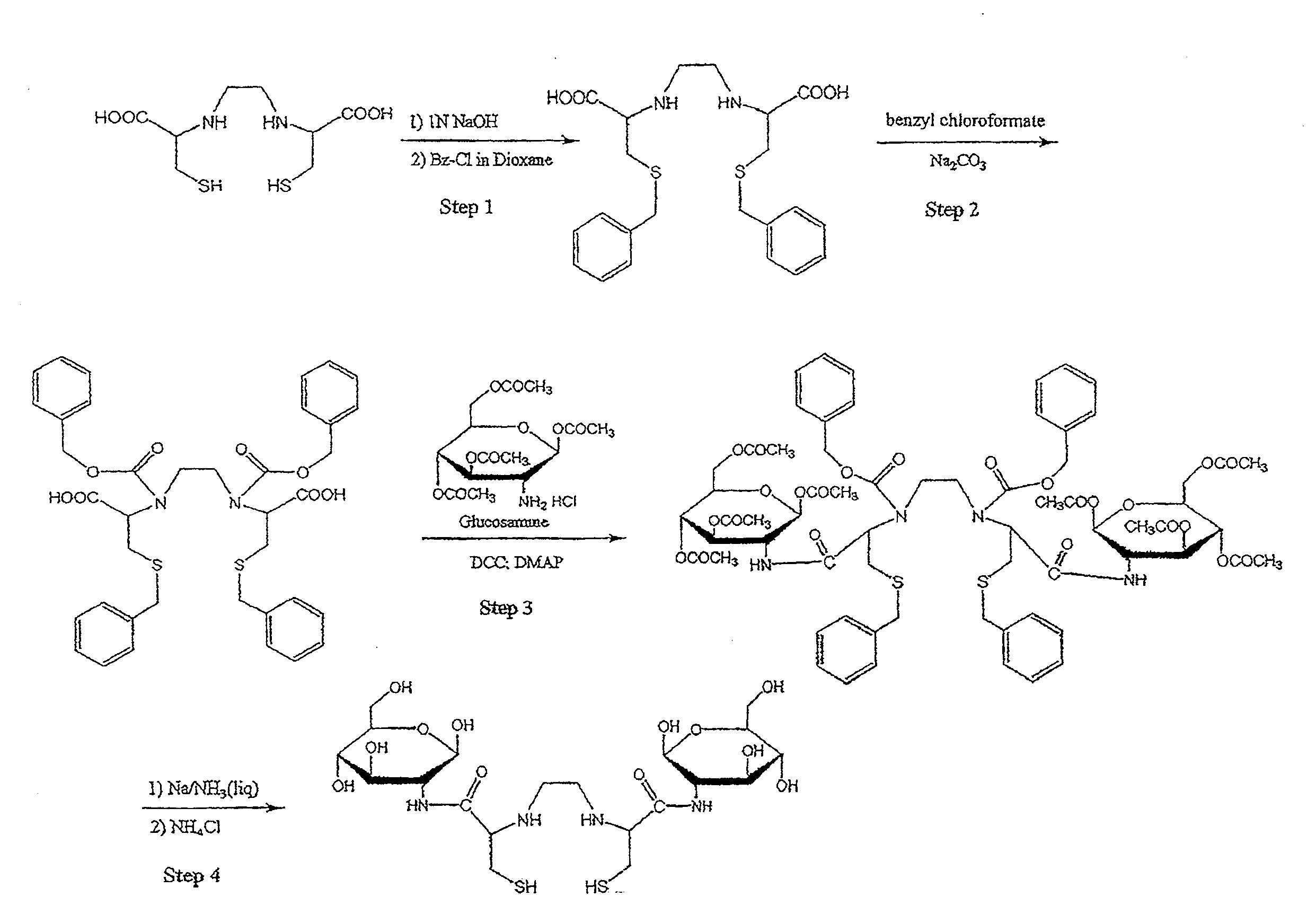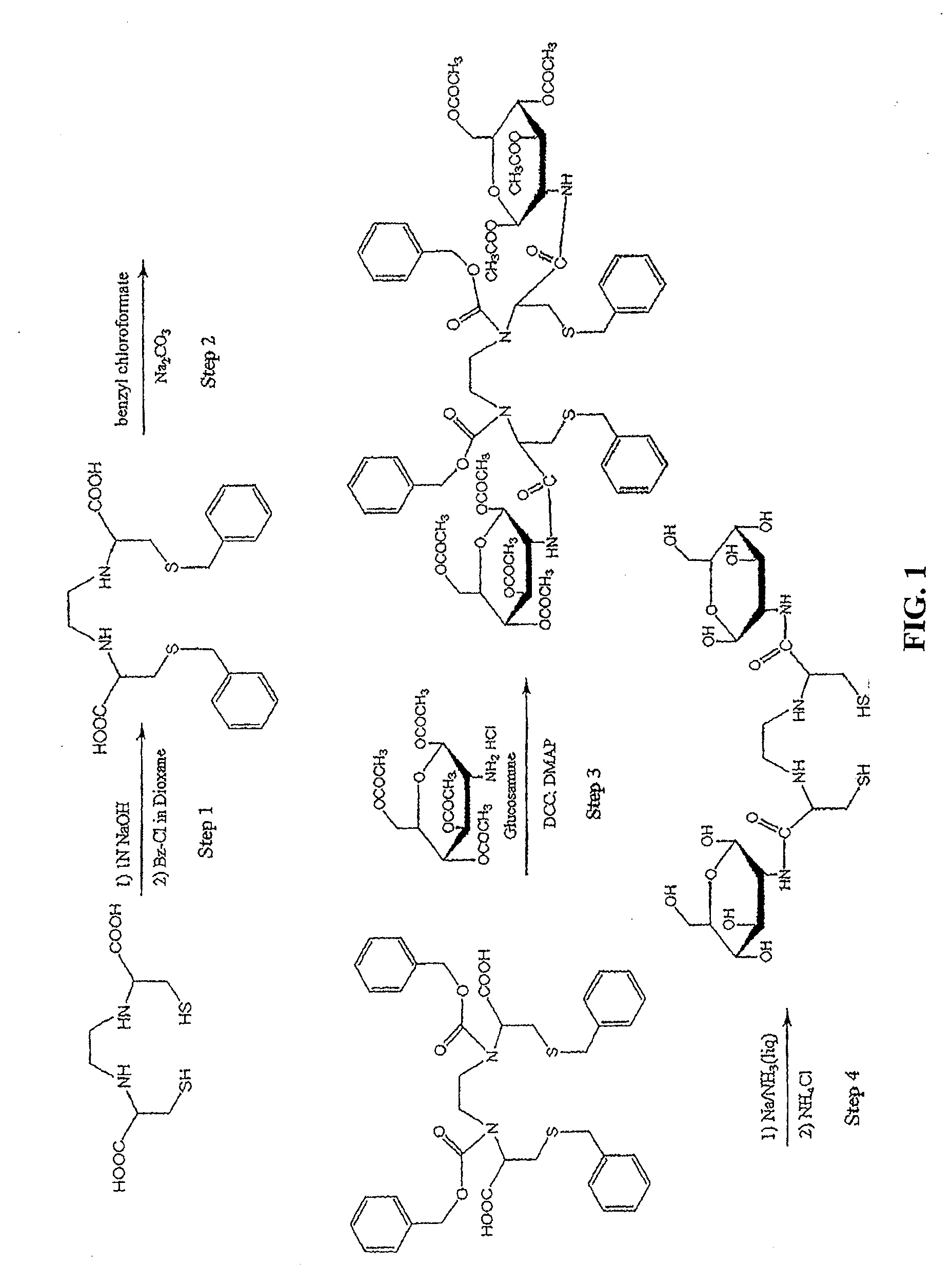Efficient Synthesis of Chelators for Nuclear Imaging and Radiotherapy: Compositions and Applications
a chelator and nuclear imaging technology, applied in the field of chemical synthesis, can solve the problems of difficult attachment of 99m/sup>tc to drugs for imaging purposes, limited usefulness of organic metals chelated in this manner, and the need for rapid pet radiosynthesis, etc., to achieve better candidates, wide flexibility and selectivity, and high purity
- Summary
- Abstract
- Description
- Claims
- Application Information
AI Technical Summary
Benefits of technology
Problems solved by technology
Method used
Image
Examples
example 1
[0437]Non-Limiting Example of an Organic Synthesis of N,N-Ethylenedicysteine-Glucosamine (EC-G). See FIG. 1.
Step 1: Synthesis of S,S′-Bis-benzyl-N,N′-ethylenedicysteine (Bz-EC)
[0438]Cysteine-HCl (30 g) was dissolved in water (100 mL). To this, 37% formaldehyde (22.3 mL) was added and the reaction mixture was stirred overnight at room temperature. Pyridine (25 mL) was then added and a precipitate formed. The crystals were separated and washed with ethanol (50 mL), then filtered with a Buchner funnel. The crystals were triturated with petroleum ether (150 mL), again filtered and dried. The precursor, L-thiazolidine-4-carboxylic acid (m.p. 195° C., reported 196-197° C.) weighed 23.408 g. The precursor (22 g) was dissolved in liquid ammonia (200 mL) and refluxed. Sodium metal was added until a persistent blue color appeared for 15 min. Ammonium chloride was added to the blue solution, the solvents were evaporated to dryness. The residue was dissolved in water (200 mL) and the pH was adj...
example 2
Non-Limiting Example of an Organic Synthesis of 187Re-EC-G Using Re-EC and Protected Glucosamine See FIG. 2
[0442]187Re-EC-G was used as a reference standard for 99mTc-EC due to the similarity in structure and lipophilicity. Synthesis of cold Re-EC-G is shown in FIG. 2. To a stirred ethanol solution, small metal sodium chips (144.8 mg, 6.3 mmol) were added slowly into 10 mL of ethanol in a 50 mL bottle under nitrogen. After the sodium metal dissolved, EC (536.8 mg, 2.0 mmol) was added. The reaction mixture was stirred for 1 hour at room temperature in order to form EC-Na salt. Triphenylphosphine rhenium chloride (ReOCl3(PPh3)2, 1.8329 g, 2.2 mmol) was added. The olive green color of ReOCl3(PPh3)2 changed to a forest green color. The reaction mixture was stirred for 1 hour and then refluxed for 30 min. The reaction mixture was then filtered and the filtrate was evaporated to dryness yielding a gray-purple powder Re-EC (818.4 mg, 80% yield). The structure of Re-EC was confirmed by H-1 ...
example 3
Synthesis of EC-G Using EC and Glucosamine in an Aqueous Reaction
[0445]EC (107 mg, 0.4 mmol) was dissolved in NaHCO3 (1N, 12 mL). To this colorless solution, sulfo-N-hydroxysuccinimide (sulfo-NHS, 173.7 mg, 0.8 mmol) and 1-ethyl-3-(3-dimethylaminopropyl)carbodiimide-HCl (EDAC) (Aldrich Chemical Co, Milwaukee, Wis.) (153.4 mg, 0 8 mmol) were added. D-Glucosamine hydrochloride salt (Sigma Chemical Co., St Louis, Mo.) (345 mg, 1.6 mmol) was then added. A pH of 8 was measured. The mixture was stirred at room temperature for 16 hours and then dialyzed for 24 hours using Spectra / POR molecular porous membrane with cut-off at 500 (Spectrum Medical Industries Inc., Houston, Tex.). After dialysis, the product was filtered by a 0 45 μm Nylon-filter and then freeze-dried using a lyophilizer (Labconco, Kansas City, Mo.). The crude product weighed 300-400 mg. H-1 NMR of EC-G showed similar patterns; however, it appears that the mixture is not as pure when compared to the organic EC-G. Elemental a...
PUM
| Property | Measurement | Unit |
|---|---|---|
| β energy | aaaaa | aaaaa |
| gamma energy | aaaaa | aaaaa |
| time | aaaaa | aaaaa |
Abstract
Description
Claims
Application Information
 Login to View More
Login to View More - R&D
- Intellectual Property
- Life Sciences
- Materials
- Tech Scout
- Unparalleled Data Quality
- Higher Quality Content
- 60% Fewer Hallucinations
Browse by: Latest US Patents, China's latest patents, Technical Efficacy Thesaurus, Application Domain, Technology Topic, Popular Technical Reports.
© 2025 PatSnap. All rights reserved.Legal|Privacy policy|Modern Slavery Act Transparency Statement|Sitemap|About US| Contact US: help@patsnap.com



